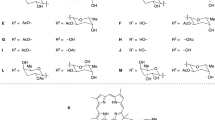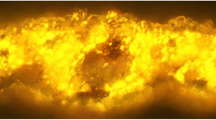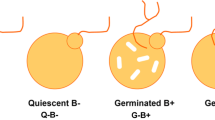Abstract
Myxococcus xanthus is a common soil bacterium with a complex life cycle, which is known for production of secondary metabolites. However, little is known about the effects of nutrient availability on M. xanthus metabolite production. In this study, we utilize confocal Raman microscopy (CRM) to examine the spatiotemporal distribution of chemical signatures secreted by M. xanthus and their response to varied nutrient availability. Ten distinct spectral features are observed by CRM from M. xanthus grown on nutrient-rich medium. However, when M. xanthus is constrained to grow under nutrient-limited conditions, by starving it of casitone, it develops fruiting bodies, and the accompanying Raman microspectra are dramatically altered. The reduced metabolic state engendered by the absence of casitone in the medium is associated with reduced, or completely eliminated, features at 1140 cm−1, 1560 cm−1, and 1648 cm−1. In their place, a feature at 1537 cm−1 is observed, this feature being tentatively assigned to a transitional phase important for cellular adaptation to varying environmental conditions. In addition, correlating principal component analysis heat maps with optical images illustrates how fruiting bodies in the center co-exist with motile cells at the colony edge. While the metabolites responsible for these Raman features are not completely identified, three M. xanthus peaks at 1004, 1151, and 1510 cm−1 are consistent with the production of lycopene. Thus, a combination of CRM imaging and PCA enables the spatial mapping of spectral signatures of secreted factors from M. xanthus and their correlation with metabolic conditions.
Graphical abstract






Similar content being viewed by others
References
Berleman JE, Scott J, Chumley T, Kirby JR. Predataxis behavior in Myxococcus xanthus. Proc Natl Acad Sci USA. 2008;105(44):17127–32.
Brown PJ, Kysela DT, Brun YV, editors. Polarity and the diversity of growth mechanisms in bacteria. Semin Cell Dev Biol; 2011: Elsevier.
Dworkin M, Kaiser D. Cell interactions in myxobacterial growth and development. Science. 1985;230(4721):18–24.
Campos JM, Zusman DR. Regulation of development in Myxococcus xanthus: effect of 3′: 5′-cyclic AMP, ADP, and nutrition. Proc Natl Acad Sci USA. 1975;72(2):518–22.
Kaiser D. Coupling cell movement to multicellular development in myxobacteria. Nat Rev Microbiol. 2003;1(1):45–54.
Kaiser D, Welch R. Dynamics of fruiting body morphogenesis. J Bacteriol. 2004;186(4):919–27.
Giglio KM, Caberoy N, Suen G, Kaiser D, Garza AG. A cascade of coregulating enhancer binding proteins initiates and propagates a multicellular developmental program. Proc Natl Acad Sci USA. 2011;108(32):E431–9.
Krug D, Zurek G, Revermann O, Vos M, Velicer GJ, Müller R. Discovering the hidden secondary metabolome of Myxococcus xanthus: a study of intraspecific diversity. Appl Environ Microbiol. 2008;74(10):3058–68.
Martinez-Laborda A, Balsalobre JM, Fontes M, Murillo FJ. Accumulation of carotenoids in structural and regulatory mutants of the bacterium Myxococcus xanthus. Mol Gen Genet MGG. 1990;223(2):205–10.
Iniesta AA, Cervantes M, Murillo FJ. Cooperation of two carotene desaturases in the production of lycopene in Myxococcus xanthus. FEBS J. 2007;274(16):4306–14.
Bode HB, Müller R. Analysis of myxobacterial secondary metabolism goes molecular. J Ind Microbiol Biotechnol. 2006;33(7):577–88.
Gerth K, Jansen R, Reifenstahl G, Höfle G, Irschik H, Kunze B, et al. The myxalamids, new antibiotics from Myxococcus xanthus (Myxobacterales). J Antibiot. 1983;36(9):1150–6.
Meiser P, Weissman KJ, Bode HB, Krug D, Dickschat JS, Sandmann A, et al. DKxanthene biosynthesis—understanding the basis for diversity-oriented synthesis in myxobacterial secondary metabolism. Chem Biol. 2008;15(8):771–81.
Xiao Y, Gerth K, Müller R, Wall D. Myxobacterium-produced antibiotic TA (myxovirescin) inhibits type II signal peptidase. Antimicrob Agents Chemother. 2012;56(4):2014–21.
Burchard RP, Dworkin M. Light-induced lysis and carotenogenesis in Myxococcus xanthus. J Bacteriol. 1966;91(2):535–45.
Furusawa G, Dziewanowska K, Stone H, Settles M, Hartzell P. Global analysis of phase variation in Myxococcus xanthus. Mol Microbiol. 2011;81(3):784–804.
Meiser P, Bode HB, Müller R. The unique DKxanthene secondary metabolite family from the myxobacterium Myxococcus xanthus is required for developmental sporulation. Proc Natl Acad Sci USA. 2006;103(50):19128–33.
Ember KJ, Hoeve MA, McAughtrie SL, Bergholt MS, Dwyer BJ, Stevens MM, et al. Raman spectroscopy and regenerative medicine: a review. NPJ Regenerative medicine. 2017;2(1):1–10.
Baig N, Polisetti S, Morales-Soto N, Dunham SJ, Sweedler JV, Shrout JD, et al., editors. Label-free molecular imaging of bacterial communities of the opportunistic pathogen Pseudomonas aeruginosa. Biosensing and Nanomedicine IX; 2016: International Society for Optics and Photonics.
Butler HJ, Ashton L, Bird B, Cinque G, Curtis K, Dorney J, et al. Using Raman spectroscopy to characterize biological materials. Nat Protoc. 2016;11(4):664–87.
Polisetti S, Baig NF, Morales-Soto N, Shrout JD, Bohn PW. Spatial mapping of pyocyanin in Pseudomonas aeruginosa bacterial communities using surface enhanced Raman scattering. Appl Spectrosc. 2017;71(2):215–23.
Petry R, Schmitt M, Popp J. Raman spectroscopy—a prospective tool in the life sciences. ChemPhysChem. 2003;4(1):14–30.
Sandt C, Smith-Palmer T, Pink J, Brennan L, Pink D. Confocal Raman microspectroscopy as a tool for studying the chemical heterogeneities of biofilms in situ. J Appl Microbiol. 2007;103(5):1808–20.
Polisetti S, Bible AN, Morrell-Falvey JL, Bohn PW. Raman chemical imaging of the rhizosphere bacterium Pantoea sp. YR343 and its co-culture with Arabidopsis thaliana. Analyst. 2016;141(7):2175–82.
Do H, Kwon S-R, Fu K, Morales-Soto N, Shrout JD, Bohn PW. Electrochemical surface-enhanced Raman spectroscopy of pyocyanin secreted by Pseudomonas aeruginosa Communities. Langmuir. 2019;35(21):7043–9.
Cao T, Morales-Soto N, Jia J, Baig NF, Dunham SJ, Ellis J, et al., editors. Spatiotemporal dynamics of molecular messaging in bacterial co-cultures studied by multimodal chemical imaging. Photonic Diagnosis and Treatment of Infections and Inflammatory Diseases II; 2019: International Society for Optics and Photonics.
Harvey CW, Madukoma CS, Mahserejian S, Alber MS, Shrout JD. Cell division resets polarity and motility for the bacterium Myxococcus xanthus. J Bacteriol. 2014;196(22):3853–61.
Hodgkin J, Kaiser D. Cell-to-cell stimulation of movement in nonmotile mutants of Myxococcus. Proc Natl Acad Sci USA. 1977;74(7):2938–42.
Ahlf DR, Masyuko RN, Hummon AB, Bohn PW. Correlated mass spectrometry imaging and confocal Raman microscopy for studies of three-dimensional cell culture sections. Analyst. 2014;139(18):4578–85.
Schulz H, Baranska M, Baranski R. Potential of NIR‐FT‐Raman spectroscopy in natural carotenoid analysis. Biopolymers: Original Research on Biomolecules. 2005;77(4):212–21.
Baranska M, Schütze W, Schulz H. Determination of lycopene and β-carotene content in tomato fruits and related products: comparison of FT-Raman, ATR-IR, and NIR spectroscopy. Anal Chem. 2006;78(24):8456–61.
Acknowledgements
This work was supported by the Department of Energy Office of Science through grant DE-SC0019312. The authors are grateful to the Notre Dame Integrated Imaging Facility for assistance with various electron imaging measurements.
Author information
Authors and Affiliations
Corresponding author
Ethics declarations
Conflict of interest
The authors declare no competing interests.
Additional information
Publisher's note
Springer Nature remains neutral with regard to jurisdictional claims in published maps and institutional affiliations.
Supplementary Information
Below is the link to the electronic supplementary material.
Rights and permissions
About this article
Cite this article
Do, H., Madukoma, C.S., Sundaresan, V. et al. Spatiotemporal distribution of chemical signatures exhibited by Myxococcus xanthus in response to metabolic conditions. Anal Bioanal Chem 414, 1691–1698 (2022). https://doi.org/10.1007/s00216-021-03795-6
Received:
Revised:
Accepted:
Published:
Issue Date:
DOI: https://doi.org/10.1007/s00216-021-03795-6




